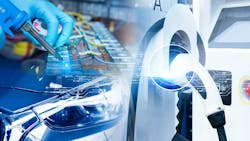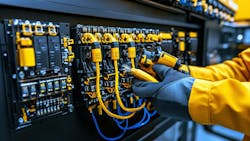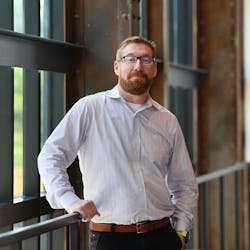Safety Factors to Consider When Working with Electrification Systems
When developing electrification systems for mobile equipment applications, maintaining safety throughout the process is vital. The high voltages commonly used with these systems pose a real danger if safety precautions are not taken.
As many of these machines are still utilizing hydraulics and pneumatics, it is important for design teams pairing fluid power and electric technologies to have an understanding of the potential safety concerns and best practices.
Register for the Webinar to Learn More
Register for the webinar "The Importance of Safety When Developing Electrification Systems" which took place Thursday, June 5, 2025 and is now available for on-demand viewing for more insights on maintaining safety while working with electrification systems.
In this excerpt from Power & Motion’s webinar “The Importance of Safety When Developing Electrification Systems,” the following panel of industry experts working in the fluid power and electrification space offer their insights on safety factors to consider as well as tips on how to ensure safety:
- Harshil Patel, Systems Engineer, Bosch Rexroth
- Mourad Chergui, Senior Product Manager, Delta-Q Technologies, a ZAPI GROUP company
- Michael Terzo, P.E., CEO of Xirro, LLC and Co-Founder of HeavyTech, Inc.
- DJ O’Konek, Engineering Manager, Nott Company
*Editor’s Note: Questions and responses have been edited for clarity.
Power & Motion: When working with electrification systems during their design, testing and/or integration, what are some of the key safety factors to keep in mind?
Mike Terzo: On electrification systems, if we're talking about the whole system while we're doing integration or testing, something I always try to keep in mind is that unintended motion is always possible. As you're going through hooking stuff up, hooking up communications, whatever it is, you have to always be thinking that something could move when you don't think it's going to move. That's always going to be a safety consideration.
And then, of course, if we're dealing with anything even remotely high voltage…any wire can be live. You always have to think about that.
DJ O’Konek: You always want to know how you want something to fail and test for it to do so because there's lots of scenarios you can come across where, if you're not testing to see if it fails in your expected manner, bad things can happen. The other thing is making sure all the people that are around it [the electrification system] have the proper PPE (personal protective equipment), proper training, especially when it comes to high voltage systems, because you can't see electricity. It's not like fluid, where you can see when there's a leak; like Mike said any wire can be live at any given time.
All of our guys [at Nott Co.] go through the SAE safety training courses, and one of those classes actually is specifically on PPE — the [use of] high voltage gloves and making sure to test circuits with a multimeter or any other high voltage testing device to make sure that wires are off when you expect them to be off.
Harshil Patel: I would like to add that you want to make sure of the high voltage isolation. So, you want to keep your circuit separate low voltage, high voltage versus positive, negative terminals. You want to have proper grounding on each and every component you have on the system that is basically running on high voltage. You want proper insulation integrity to avoid breakdowns and hazards. And you also want to integrate proper shut-off mechanisms into your system.
If at any point you want to make sure that you're safe, you can always trigger the shut-off mechanism. Plus, when you're working with high voltage, you always want to make sure that the manual service disconnects are always disconnected from the system, and you have a lockout tagout tag on the MSD (manual service disconnect). That's a quick way of knowing there is no high voltage active from the source side.
Mourad Chergui: In addition, there is also the operation of the vehicle or the system after it's in the hands of the user, and even later, like maintenance and even decommissioning and maybe recycling the product that have to be taken into consideration.
From my own experience working for a battery charging company, when we talk about these electrical systems, there are all these problems that are either inherent in terms of electrical voltage or functional safety. There is another aspect — in many of the systems we use batteries, and the batteries themselves introduce another set of challenges, for example, there is a risk of explosion, there is chemicals — so that also needs to be taken in consideration during the design as well as the operation of the vehicle.
Power & Motion: What safety lessons have you learned during your time designing, testing and/or integrating electrification systems?
Harshil Patel: I've learned that assumptions about system voltage levels can lead to dangerous oversights. You always want to make sure that high voltage is not active. One thing I would say is to keep a Category III or Category IV multimeter always handy that's at least rated for 1,000V, as DJ mentioned in the previous question, so you can always test the system and make sure that it's really shut off before operating any of the components.
DJ O’Konek: You always need to assume that the software is going to have bugs when you bring a system online. There are very few control systems that come online and work right out of the box. And also, there's most likely going to be wiring errors in your system that you're going to have to diagnose and troubleshoot. And honestly, I mean, it kind of goes back to Mike's first comment, unintended motion is going to occur.
Mike Terzo: I think probably one of the biggest ones is, don't trust anything. When we're doing integration, when we're doing testing, we're usually hyper aware of safety. A real-world example, we were actually at a large customer site, and there was a whole bunch of production-ready vehicles…and an engineer in front of me unplugged an HVIL (high-voltage interlock loop) because we thought it was active. It turns out the HVIL was not hooked up on the production units and he had his fingers about a centimeter away from 800V DC. I almost [saw him] die in front of me, because he assumed an HVIL works on a production unit. So, I think that goes back to the earlier point of you just always have to assume that a wire is live.
Mourad Chergui: When we are working with electrification, we are used to certain standards for what we do. But when we move to different industries or maybe different voltages, we have to actually [take] a broader perspective not only bound by the standards that we have but also look beyond those because not everything is covered. This [electrification] is something new, it's innovative [for many industries and] not everything is covered [by the immediately available standard].
Every day, every year there are more new [standards] but we are still far behind. The industry has to get together to develop these standards for the benefit of everyone. Some companies have developed their own, there are some specific industries that wrote their own but there is still a lack of international or original standards that are better for what we deal with right now.
Power & Motion: Do you see there may be a need for some more standards or safety related information in the industry?
DJ O’Konek: I think SAE International, IEC (International Electrotechnical Commission) and ISO (International Organization for Standardization) are all doing a good job of codifying the standards as they come up, but they're behind the curve. With the market and the industry growing as fast as it is, it's tough to keep up, but there's obviously room to grow, and I think the people that are intimate with this need to get involved in those organizations to help drive those changes in the standards and keep them up to date.
There is training out there available if you're first getting into the industry; make sure and take advantage of that training. It's at least a good starting point for everything.
Harshil Patel: There are various ISO and IEC standards that are already set for high voltage handling, fault detection and emergency response procedures. They are, like DJ mentioned, not quite there yet, but you at least have some basics where you can start from. For a good reference, you could start with IEC 61508, that's an internationally followed standard for all electronics, electrical and programmable electrical systems.
Mike Terzo: I'm going to double down on what DJ said. The problem is that [with] the larger standardization organizations, especially from my background as a startup, we usually don't even have money to buy the standards, let alone find them, research them — that is a huge issue. I think we need to make an industry call to say, they're [standards organizations] going to catch up, but we know they're years and years behind the actual industry, just their pace of creating that type of standardization. In the meantime, we need an accessible form of information for people that are in the industry. I don't think that exists. We should figure out how do we get best practices; not to the level of any kind of ISO or SAE standards, because that's really deep in the weeds. We need just basic best practices.
I don't really think there's much out there. Even at really large corporations, they still have small electrification teams working across all kinds of domains. It's still hard to find that information. So, it would be nice if we figure out how to just get some general best practices, but I do understand, nobody wants to take the liability to say, what is that best practice.
Mourad Chergui: I'll start with where Mike left off. Very good points, small organizations and small companies, they struggle with this. So, what I would say is, keep asking for this [industry standards]…as well as take an active approach in getting into the standards organizations, or maybe lobby your colleagues, or maybe in the industry to say ‘let's work together so that I don't take the full burden of [creating standards to follow]’.
There are some good practices [in other industries]…particularly the automotive industry, which has embarked on electrification for a long time, as well as the IT industry because it has been using all these electrical systems for a long time, and they have developed a lot of standards and a lot of practices over the years. So, I think we can borrow [some best practices] from them.
But I agree with Mike, it's difficult. I have experienced that myself. Standards cost hundreds and thousands of dollars just to get and even studying them is very complicated and it's time consuming, but I think that investment is needed.
About the Author
Sara Jensen
Executive Editor, Power & Motion
Sara Jensen is executive editor of Power & Motion, directing expanded coverage into the modern fluid power space, as well as mechatronic and smart technologies. She has over 15 years of publishing experience. Prior to Power & Motion she spent 11 years with a trade publication for engineers of heavy-duty equipment, the last 3 of which were as the editor and brand lead. Over the course of her time in the B2B industry, Sara has gained an extensive knowledge of various heavy-duty equipment industries — including construction, agriculture, mining and on-road trucks —along with the systems and market trends which impact them such as fluid power and electronic motion control technologies.
You can follow Sara and Power & Motion via the following social media handles:
X (formerly Twitter): @TechnlgyEditor and @PowerMotionTech
LinkedIn: @SaraJensen and @Power&Motion
Facebook: @PowerMotionTech

Leaders relevant to this article:







